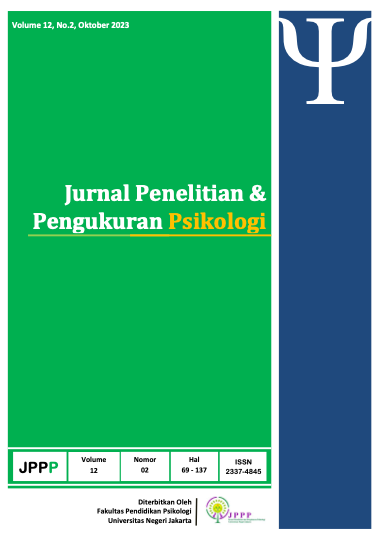e-LIT: Pengembangan Instrumen Penilaian Literasi Digital bagi Generasi Digital-Native
DOI:
https://doi.org/10.21009/JPPP.122.08Keywords:
digital literacy test, digital technologies, internet, LD-UAJ test, psychometric evaluationAbstract
Digital literacy is becoming increasingly important in the current era of digitalization, but the level of digital literacy in Indonesia is still low. This research aims to develop and test the psychometric properties of the LD-UAJ Digital Literacy Test as a measure of students' digital literacy abilities. The LD-UAJ test is designed to measure the minimum proficiency in digital technology before entering the workforce. It is an achievement test consisting of 30 multiple-choice questions that measure five dimensions of digital literacy: information and data literacy, communication and collaboration, digital competence, security, and problem-solving.
The development of the LD-UAJ digital literacy test involved two data collection phases with 97 active undergraduate students. Through the convenience sampling technique, 46 participants were involved in the pilot test, and 51 in the field test. In this study, item analysis, validity, and reliability methods were used to evaluate the psychometric properties of the LD-UAJ test. The analysis results show that the LD-UAJ test has good validity in terms of content validity, particularly through expert opinions, and face validity with the participants. The reliability results indicate that the LD-UAJ test is reliable with an omega coefficient of 0.82.
Further research is needed to validate the criterion-related validity as the criteria used during the development did not show a strong relationship with digital literacy. This study also highlights the existing barriers in the development of the LD-UAJ test, such as time limitations, low student interest and participation, and difficulties in obtaining a sufficiently large sample. However, the LD-UAJ test is expected to be a useful measuring tool in evaluating students' level of digital literacy and can help recommend appropriate training to enhance their digital literacy understanding.
Keywords:
References
Bak, C. K., Krammer, J. Ø., Dadaczynski, K., Orkan, O., von Seelen, J., Prinds, C., Søbjerg, L. M., & Klakk, H. (2022). Digital health literacy and information-seeking behavior among university college students during the COVID-19 pandemic: A Cross-Sectional Study from Denmark. International journal of environmental research and public health, 19(6), 3676. https://doi.org/10.3390/ijerph19063676
Casillas-Martín, S., Cabezas-González, M., & García-Valcárcel Muñoz-Repiso, A. (2020). Análisis psicométrico de una prueba para evaluar la competencia digital de estudiantes de Educación Obligatoria. RELIEVE - Revista Electrónica de Investigación y Evaluación Educativa, 26(2), 1-21. https://doi.org/10.7203/relieve.26.2.17611
Covello, S. (2010, Mei 2). A review of digital literacy assessment instruments. Syracuse University School of Education. https://www.academia.edu/7935447/A_Review_of_Digital_Literacy_Assessment_Instruments
GoGuardian Team. (2020, Juni 9). How does technology prepare students for the future?. GoGuardian | Engaging Digital Learning for Schools. https://www.goguardian.com/blog/how-does-technology-prepare-students-for-the-future
IDN Research Institute. (2022) Indonesia millenial report 2022. IDN Media.
Karpati, A. (2011, Mei). Digital literacy in education. UNESCO Institute for Information Technologies in Education. https://unesdoc.unesco.org/ark:/48223/pf0000214485.locale=en
Krelová, K.K., Berková, K., Krpálek, P., & Kubišová, A. (2021). Attitudes of Czech college students toward digital literacy and their technical aids in times of COVID-19. Int. J. Eng. Pedagog., 11, 130-147.
Muliani, A., Karimah, F. M., Liana, M. A., Pramudita, S. A. E., Riza, M. K., & Indramayu, A. (2021) Pentingnya peran literasi digital bagi mahasiswa di era revolusi industry 4.0 untuk kemajuan Indonesia. Journal of Education and Technology, 1(2), 87-92
Noorrizki, R. D., Abadi, D., Siwi, N. S. W., Sa’id, M., Mantara, A. Y., & Ramadhani, F. (2022). Factors affecting digital literacy in young adults. KnE Social Sciences 7(18), 308-315. https://doi.org/10.18502/kss.v7i18.12396
Panggabean, S., Saragih, R. B., Sitorus, M. O. M., & Lubis, D. L. (2023). Student digital literacy competence study language and literature education program Indonesia. Edumaspul – Journal of Education, 7(1), 942-945
Pangrazio, L., Godhe, A.-L., & Ledesma, A. G. L. (2020). What is digital literacy? A comparative review of publications across three language contexts. E-Learning and Digital Media, 17(6), 442–459. https://doi.org/10.1177/2042753020946291
Saputra, H. N. & Salim. (2020). Potret sikap mahasiswa dalam penggunaan literasi digital. Jurnal Komunikasi Pendidikan, 4(2). https://doi.org/
Silvhiany, S., Huzaifah, S., & Ismet. (2021). Critical digital literacy: EFL students’ ability to evaluate online sources. Indonesian Journal of EFL and Linguistics, 6(1), 250–269. https://dx.doi.org/10.21462/ijefl.v6i1.364
UNESCO Institute for Statistics (UIS). (2018). A global framework of reference on digital literacy skills for indicator 4.4.2. Information Paper No.51, https://uis.unesco.org/sites/default/files/documents/ip51-global-framework-reference-digital-literacy-skills-2018-en.pdf
Yanti, N., Mulyati, Y., Sunendar, D., & Damaianti, V. (2021). Tingkat literasi digital mahasiswa Indonesia. Diksa: Pendidikan Bahasa dan Sastra Indonesia, 7(1), 59-71, https://doi.org/10.33369/diksa.v7i1.22391







